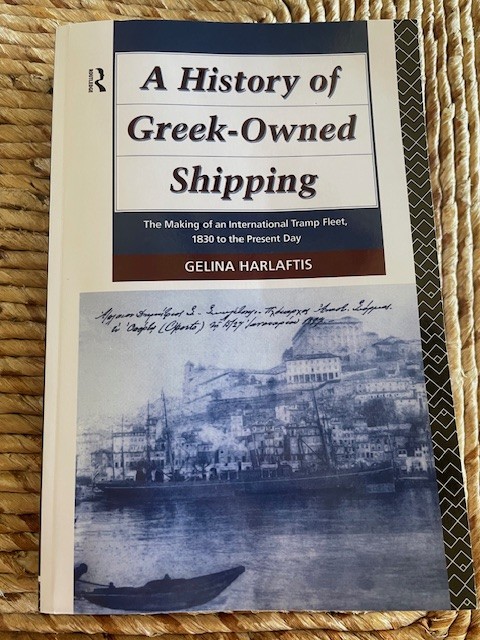
A History of Greek-Owned Shipping: The Making of an International Tramp Fleet, 1830 to the Present Day” by Gelina Harlaftis, is considered by many to be the definitive book on the modern rise of Greek shipping enterprise.
Harlaftis who is currently the Director of the Institute for Mediterranean Studies of the Foundation of Research and Technology-Hellas (FORTH), in the book, puts forth the thesis that the Greeks were able to become one of the world’s leading shipping powers not so much because of the “opportunity” that arose in post-World War II but because of the organizational structures that stretched back over a century before. Harlaftis’ point of using 1830 as a starting point for the 439-page book is that it covers the period from Greek independence to the end of the 20th Century.
Greek shipping seemingly came out of no place during the expansion period immediately following the Second World War as Costis Frangoulis, President of the Propeller Club of Piraeus relates, "At the end of the war we found ourselves with only 130 ships and in ninth place in the world ranking. Essentially, during that period the restart of our shipping began. We have to specifically single out five Greek shipping groups: Stavros Niarchos, Stavros Livanos, Aristotle Onassis, Petros Goulandris Sons, and Rethymni-Kulukundis because in that period and out of a total of 65 groups, these Big 5 made 40% of total newbuild orders. These five groups created the conditions for the next day of our shipping. Both Niarchos and Onassis were the ones who stood out with the rapid and enormous development of their fleets. They were international innovators and pioneers both with the adoption of flags of opportunity - the Niarchos of Liberia and Onassis of Panama - the invention of supertankers, while also introducing a new type of financing of up to 100% of their new constructions, with long-term charters that they secured and deposited as collateral with banks. In general, their very high social visibility at an international level, combined with their enormous business work inside and outside Greece, inspired and gave a significant boost to Greek shipping, capable of reaching the top in the early 1980s."
Frangoulis pointed out that in the period 1948-2000, Greece: “built a ship every 8 days, while from 2000 to today the Greeks build a ship every 3 days which is equivalent to 100 ships a year, creating a modern fleet today with an average age of 10 years … Let's also not forget that the Greek shipowners started the new constructions in the Japanese shipyards very early, only in 1952 and twenty years later in the [South] Korean ones and the shipbuilding giant Hyundai started its activities in 1972 with the orders of the two VLCCs of Georgios Stavros Livanos.”
A Family Affair
The leadership role that Greeks have played in shipping owes a lot to family and kinship as Gelina Harlaftis recounts in her detailed maritime history, “The attitude and practices of the traditional shipowning families in the 20th century resembled those of the 19th century. Intermarriages were used extensively to keep businesses within close circles. Respect for tradition continued to be very important, and beliefs were passed on carefully to new generations. Each firm was run by one man who controlled the greatest part of ownership and decision-making. Occasionally, a firm was run by a group from the same family, usually brothers. The most close circle of all was the so-called ‘London Greeks’, and particularly the Chiots. More specifically, those from Oinousssai continued almost identical practices to the 19th century Chiots …Even more impressive is that Greeks who were born and have lived all their lives in England, speak Greek with a particular island accent, follow the local customs, and return to get married or buried in Greece. Many Chiots, Kassians Cephalonians, and Andriots were born and raised abroad, and came back to Piraeus to run the family shipping agency. Others may not speak good Greek, especially those brought up in the United States, but still are aware of the family's traditions and work in the family's firms abroad.”
Adaptability
However, for all the family ties and traditions, Greek shipowners’ business acumen, which always included great adaptability to economic conditions, was key to the success. In the book, Harlaftis chronicles that the same shipowning family that had carried grain from the Black Sea to Marseille, London, and Antwerp in the early 20th century, “hauled grain from Buenos Aires to London in the interwar period, and from Australia, the US, and Argentina to China and India in the post-Second World War years.” Involvement in tramp shipping also “enabled the Greeks to adjust to new demands in international markets, whether this involved new types of cargoes or ships, for example, when there was increased demand for oil, Greeks bought the appropriate ships to carry it; when there was an increased demand for the five main bulk cargoes, Greeks bought bulk carriers to transport them.”
For those interested in commercial maritime history, Harlaftis’ book offers great insight into the evolution of the rise of Greek shipowners. It is a most worthy read.

